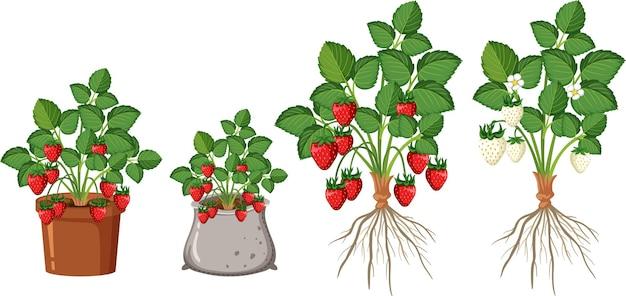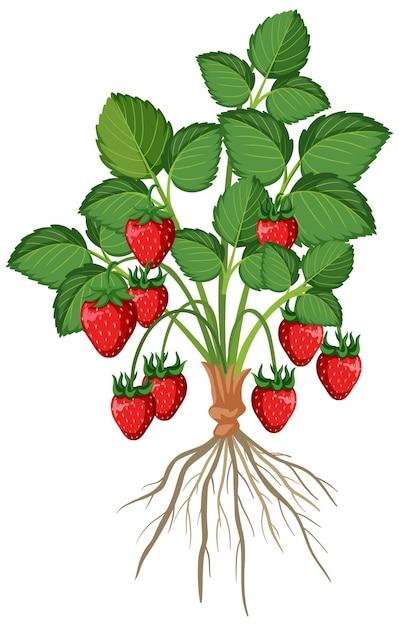Strawberries are a delicious and popular fruit that many people enjoy, whether eaten fresh or used in various culinary creations. But have you ever wondered about the different parts of a strawberry plant? One essential component is the crown of the plant, which plays a crucial role in its growth and productivity.
In this blog post, we’ll dive deep into the world of strawberry crowns, exploring their purpose and how they contribute to the overall health of the plant. We’ll also address common issues like crown rot and share tips on how to maximize your strawberry plant’s fruit production.
So, whether you’re a seasoned strawberry grower or just starting your journey, keep reading to discover the secrets of the crown and unlock the full potential of your strawberry plants.
What is the Crown of a Strawberry Plant
The crown of a strawberry plant holds all the glory that makes a strawberry irresistible. It’s like the reigning monarch, sitting majestically at the top of the plant, wearing its leafy crown with pride. 🍓👑
The Majesty of the Crown
When you gaze upon a strawberry plant, you might wonder, “Where is this illustrious crown they speak of?” Well, my curious friend, let me enlighten you. The crown of a strawberry plant is essentially the base from which all the magic happens. It’s the part that connects the roots and the leaves and plays an essential role in the strawberry’s growth and development.
All Hail the Centerpiece
Imagine yourself at a royal banquet, the center of attention. That’s what the crown is to a strawberry plant—a show-stopping centerpiece. It sits just above the soil surface, boasting a collection of buds ready to burst into a bountiful display of flowers and, eventually, delectable strawberries.
Royalty Runs Deep
Just like a regal bloodline, the crown of a strawberry plant is a vital source of energy and reproduction. It sends out runners, like noble ambassadors, to create new plants and expand the strawberry dynasty. These runners are like the strawberry plant’s loyal subjects, eager to establish their own reign in faraway lands.
The Perennial Powerhouse
Unlike mere annuals, the strawberry plant is a perennial sensation! The crown acts as a resilient stronghold, surviving winter’s icy grip and resurfacing each spring with renewed vigor. It’s the heart of the plant, ready to produce more mouthwatering strawberries year after year.
Nurturing the Crown
To ensure the crown remains in its full glory, it requires a bit of TLC. Providing proper care, nutrition, and sufficient sunlight allows the crown to thrive and continue reigning over your strawberry patch. Ah, the sweet taste of success!
Long Live the Crown
Now that you’ve discovered the crown’s secrets, it’s time to appreciate the unsung hero of the strawberry plant. The crown, with its regal significance and power to produce succulent fruits, deserves all the respect and admiration. So next time you bite into a luscious strawberry, remember to thank the magnificent crown for its majestic contribution! 👑🍓
FAQ: What Is The Crown Of A Strawberry Plant
Strawberries are a beloved fruit that many people enjoy. But have you ever wondered about the different parts of a strawberry plant? In this FAQ-style guide, we will explore the crown of a strawberry plant and answer some commonly asked questions about this essential component. So, let’s get started!
What are the tops of strawberries called
The tops of strawberries are called the “crowns.” These are the part of the plant where the leaves, stems, and flowers meet. They are located at the base of the plant, just above the soil.
How do I get my strawberries to produce more fruit
To encourage your strawberry plants to produce more fruit, there are a few steps you can take:
-
Provide ample sunlight: Make sure your plants are getting at least 6-8 hours of direct sunlight per day.
-
Ensure proper soil conditions: Plant your strawberries in well-draining soil that is rich in organic matter. Regularly check and adjust the pH level of the soil to maintain optimal growing conditions.
-
Regularly fertilize: Feed your strawberry plants with a balanced organic fertilizer throughout the growing season to provide essential nutrients.
-
Prune and remove runners: Removing excessive runners and pruning older leaves can help redirect the plant’s energy towards fruit production.
-
Water adequately: Consistently water your plants, keeping the soil moist but not waterlogged.
How do you treat crown rot on strawberries
Crown rot can be a common issue for strawberry plants, but it can be treated by following these steps:
-
Identify the rot: Look for wilting, brown discoloration, or foul odor around the crown area of the plant.
-
Remove affected plants: Carefully dig up and dispose of any infected plants to prevent the spread of the disease.
-
Apply a fungicide: Treat the remaining plants with a suitable fungicide to help control the crown rot.
-
Improve drainage: Ensure that your strawberry beds have proper drainage to avoid waterlogged soil, which can lead to crown rot.
How many years do strawberry plants produce
Strawberry plants are generally productive for about three to five years. However, their productivity can decline after the first two years, so it’s advisable to replant with new crowns once their yield begins to decrease significantly.
Should I divide strawberry crowns
Dividing strawberry crowns is not necessary. Unlike some other perennial plants, strawberry crowns do not respond well to being divided. It’s best to replace older plants with new ones to maintain productivity.
What is the use of crown in a strawberry
The crown of a strawberry plant plays a vital role in the plant’s growth and development. It serves as the connection point between the roots, leaves, and stems, allowing essential nutrients and water to flow throughout the plant. Additionally, the crown is where the flowers and fruit are produced, making it a crucial part of the plant’s reproductive process.
What is a strawberry truss
A strawberry truss refers to a group of multiple flowers that are connected to the same stem. These flowers eventually develop into strawberries. Think of the truss as a team effort among the flowers to produce delicious fruits!
What are strawberry leaves
Strawberry leaves are the green, elongated structures that emerge from the crown of the plant. These leaves are responsible for photosynthesis, which provides energy for the plant’s growth and development. Additionally, they help to protect the crown and fruit from excessive sunlight and external elements.
How long does it take for bare root strawberries to produce fruit
After planting bare root strawberries, you can typically expect them to produce fruit in their second growing season. The first year is primarily focused on establishing the plant’s root system and foliage growth. Patience is key when it comes to enjoying the fruits of your labor!
What are the long stems on strawberry plants
The long stems or runners you see on strawberry plants are a natural part of their growth and reproduction. These runners, also known as stolons, have small plants (clones) forming along them. Once these plants touch the ground and take root, they can grow into new strawberry plants.
How do you keep strawberry crowns from rotting
To prevent crown rot in strawberry plants, you can take the following measures:
-
Ensure proper drainage: Plant strawberries in well-drained soil or raised beds to avoid waterlogged conditions.
-
Avoid excessive mulch: While mulching can be beneficial, make sure not to let it accumulate around the crown, as it can trap moisture and lead to rot.
-
Practice crop rotation: Avoid planting strawberries in the same soil for consecutive years. Rotating crops can minimize the risk of diseases.
-
Provide adequate spacing: Leave enough room between plants to promote air circulation and prevent crowding.
Do Strawberries need full sun
Yes, strawberries thrive in full sun. They require a minimum of 6-8 hours of direct sunlight per day to produce abundant, sweet berries. Inadequate sun exposure can lead to weak and unproductive plants.
What causes crown rot in strawberries
Crown rot in strawberries is primarily caused by fungal pathogens, such as Phytophthora crown rot or Rhizoctonia crown rot. Excessive moisture, poor drainage, and warmer soil temperatures can create favorable conditions for these pathogens to attack the crown, resulting in rotting.
What part is the crown on a strawberry plant
The crown is located at the base of a strawberry plant, just above the soil level. It is the central point where the leaves, stems, and roots originate. The crown is responsible for connecting and supporting the different parts of the plant.
What is the sweetest strawberry in the world
The ‘Bliss’ strawberry holds the title for being the sweetest strawberry in the world. This delectable variety is known for its exceptional sugar content and luscious flavor. Indulging in a ‘Bliss’ strawberry is truly a taste bud nirvana!
Where do strawberry plants grow
Strawberry plants prefer temperate climates and can be found growing in various regions around the world. They thrive in well-drained soil and are often found in home gardens, farms, and commercial strawberry fields. With the right conditions, you can successfully grow strawberry plants in your own backyard!
How shallow can you plant strawberries
When planting strawberries, it’s important to avoid burying the crown too deeply. The crown should be level with the soil surface or slightly above it. Planting too shallow or too deep can hinder the plant’s growth and productivity.
What are the parts of a strawberry plant
A strawberry plant consists of several essential parts:
-
Crown: The base of the plant where the leaves, stems, and roots meet.
-
Leaves: Green structures responsible for photosynthesis and protecting the crown and fruit.
-
Stems / Runners: Long, vine-like structures that produce clones and help propagate new plants.
-
Flowers: Delicate blooms that eventually develop into juicy strawberries.
-
Fruit: The delicious, sweet berries that we all love!
Why are my strawberries not turning red
Several factors can contribute to strawberries not turning red:
-
Immaturity: Strawberries need sufficient time to ripen, so be patient and give them time to reach their full color.
-
Lack of sunlight: Inadequate sun exposure can hinder the ripening process. Ensure your plants are receiving enough direct sunlight.
-
Cool temperatures: Strawberries need warmth to ripen properly. If the weather is too cool, the ripening process can become delayed.
-
Nutrient deficiency: Make sure your plants have access to the necessary nutrients, particularly potassium, which helps with fruit ripening.
What is the crown of the strawberry
The crown of the strawberry refers to the central part of the plant, situated above the soil, where the leaves, stems, and roots merge. It acts as the plant’s hub, supporting growth, and enabling the production of flowers and fruit.
How long does it take for strawberry crowns to sprout
After planting strawberry crowns, you can anticipate seeing sprouts emerge within 2-3 weeks, depending on growing conditions. Remember to provide adequate moisture and warmth to promote successful germination.
How can you tell if a strawberry crown is bad
When inspecting a strawberry crown, look for signs of rot or decay. A healthy crown should be firm, white, and show no signs of browning or foul odor. If the crown appears mushy, discolored, or emits an unpleasant smell, it is likely damaged or deteriorating.
Do strawberry plants regrow
Strawberry plants are perennial, meaning they have the ability to regrow year after year. However, their productivity declines over time, which is why it’s often recommended to replant with new crowns every few years for optimal fruit production.
Understanding the crown of a strawberry plant is key to successful strawberry cultivation. From its role in fruit production to the prevention and treatment of crown rot, this FAQ-style guide has covered the essential information you need. Now, armed with knowledge and a touch of humor, go forth and conquer your strawberry-growing journey!

